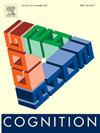时间预期对躯体感觉知觉和决策的成本和收益
IF 2.8
1区 心理学
Q1 PSYCHOLOGY, EXPERIMENTAL
引用次数: 0
摘要
我们的感知是由先前的预期塑造的,包括我们感觉的时间。这些暂时的期望可以通过在感官输入开始时识别模式来形成。然而,在体感领域,这些期望如何影响体感判断的速度和准确性仍然不清楚,因为之前的研究得出了不同的结果。在这里,参与者使用听觉音调来预测施加在他们手指上的力的开始,并与参考力相比区分它们的强度。实验1表明,被试对预期力和非预期力具有较差的区分敏感性和较高的阈值。实验2复制并扩展了这些成本,包括感知准确性,甚至在比较预期力和无预期力时也是如此,并进一步揭示了反应时间的好处。漂移-扩散模型表明,期望加速了非决策过程,同时减缓了体感证据的积累。这些发现证明了时间预期在体感知觉和决策中的成本和收益。本文章由计算机程序翻译,如有差异,请以英文原文为准。
Costs and benefits of temporal expectations on somatosensory perception and decision-making
Our perception is shaped by prior expectations, including those about the timing of our sensations. These temporal expectations can be formed by recognizing patterns in the onset of sensory inputs. However, in the somatosensory domain, it remains unclear how these expectations impact the speed and accuracy of somatosensory judgments, as previous research has yielded mixed results. Here, participants used auditory tones to anticipate the onset of forces applied to their fingers and discriminated their intensity compared to a reference force. Experiment 1 showed that participants had worse discrimination sensitivity and higher thresholds for expected versus unexpected forces. Experiment 2 replicated and extended these costs to include perceptual accuracy, even when comparing expected to expectation-free forces, and further revealed reaction time benefits. Drift-diffusion modelling suggested that expectations speeded non-decisional processes while simultaneously slowing somatosensory evidence accumulation. These findings demonstrate both costs and benefits of temporal expectations in somatosensory perception and decision-making.
求助全文
通过发布文献求助,成功后即可免费获取论文全文。
去求助
来源期刊

Cognition
PSYCHOLOGY, EXPERIMENTAL-
CiteScore
6.40
自引率
5.90%
发文量
283
期刊介绍:
Cognition is an international journal that publishes theoretical and experimental papers on the study of the mind. It covers a wide variety of subjects concerning all the different aspects of cognition, ranging from biological and experimental studies to formal analysis. Contributions from the fields of psychology, neuroscience, linguistics, computer science, mathematics, ethology and philosophy are welcome in this journal provided that they have some bearing on the functioning of the mind. In addition, the journal serves as a forum for discussion of social and political aspects of cognitive science.
 求助内容:
求助内容: 应助结果提醒方式:
应助结果提醒方式:


